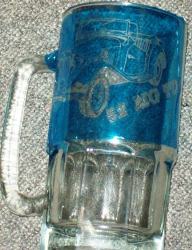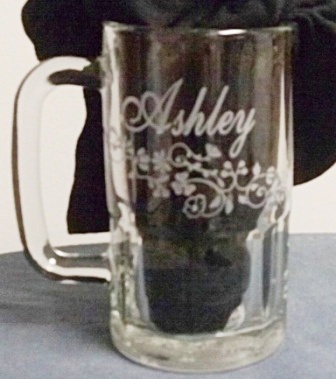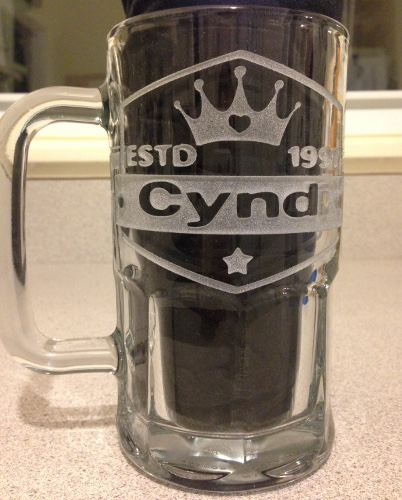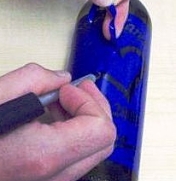
A fellow glass sandblaster, named John, emailed me about this problem, and here is my response with a bullet list of rules and actions to consider.
- Use a Finer Abrasive Grit: There could be a few things to consider, but the one that comes to mind is that the grit being used is too large. I personally use about 150 or 180 grit. I recommend that you don’t use anything larger in size than 100 grit (but my grit standards are set at least 120 and finer). Sometimes they don’t emphasis this enough, but the finer the grit is, the less blow off problems you will usually have, and the thinner the vinyl stencil can be. I talked about that in the ebook a little bit also. A lot of times, I will actually do some sandcarving (www.glassetchingsecrets.com/glasssandblasting.html) with a 3 mil vinyl with a fine grit. Works fairly nice. By the way, here are some more steps to follow for glass sandcarving.
- Ensure a Clean Surface: Another problem could be due to having a unclean surface. Even if the glass appears to look very clean, it still has oils from people’s hands. You can wipe the glass down with a cleaner such as rubbing alcohol.
- Dry Out the Resist, but not too Dry: Make sure the photoresist is dry, but not bone dry. I use the type that doesn’t require an application of adhesive. It’s most tacky when it is almost dry. If the photoresist still has moisture shown on the surface, then the it won’t adhere very well.
- Lower the Air Pressure: A fourth rule, is to make sure the sandblasting pressure isn’t set at too high of a pressure. The company will usually have a recommended and maximum pressure that can be used for each specific resist thickness. It will also explain the first rule I stated. If a larger grit is used, you may have to back off the pressure also.
Share this on social media or email by clicking below!





Good summary, it triggers two questions for me.
1. what photoresist do you use?
2. what is the threshold for “blow-through”, instead of blowoffs. Meaning, how much pressure and large grit sand can I use before I blow through the protective layer?
Hi Jason, I have been using Rayzist photoresist, but I am sure the others such as Photobrasives brand work just as well. I hear both are quality brands.
I assume your second question only pertains to the blow through of the light protective layer or the residue over the areas that need to be blasted (exposed areas) and not the actual stencil areas. I am not sure about the exact pressure and grit combination to blast through would be. It should be able to blast through at any pressure which would etch the glass. My guess would be 10-15 psi could blast through at a typical grit used such as 150 grit. Maybe I’ll test that for you. But even if you have a fine grit or a low pressure it might blast through but at a much slower rate. It could still blast through but with longer blasting time.
I assume your using a small airbrush sandblaster. Best bet would be to ask the photoresist company. I’ll try and test a low pressure setting one of these times. I hope that helps.
can you stage blast with ultra pro blue resist? if so how?
I think some people do by covering up some exposed areas with a resist plastic material. You might be able to also use a pattern with very fine lines which will prevent the resist from exposing the later stages. Then just peel them off.
I prefer not to because it is a pain so I use stencil cutters or hand cut it.
My problem when sandblasting multi-stage patterns is when using stencils with intricate elements. I number my design as do you, but when I blast one stage, I seem to blast off the lines to the next stage. I tried using a smaller tip and focusing it on the area that I’m blasting, but still, the problem persists by covering up the subsequent portions of the design. Any suggestions?
Eric,
Very helpful information!
Can you share some places that we can purchase abrasive in a smaller grit. I live in the south and have a hard time finding abrasives unless I’m willing to pay a fortune for shipping.
What size of a compressor do I need to run a pressure pot? I currently use a Harbor Freight siphone cabinet.
Eric,
I am looking to buy a nice stencil cutter machine to make my own stencils any suggestions on what models or company to buy from any help would be appreciated
Hi. I find using a 3 to 5 year sticker vinyl works well and easy to weed too. When I remove the mask it stays together more and washing the glass in hot water also helps the mask come off easier.
I find red mask works quite well to see. any other color suggestions to make weeding easier.
Thanks.